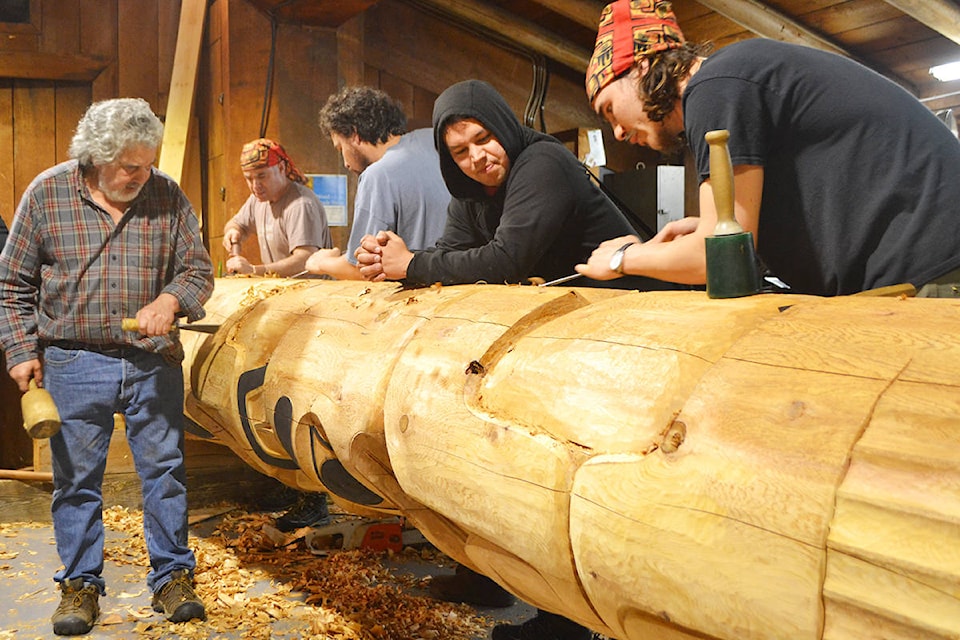By George Rammell
I first heard of the Haida in my Grade 4 classes at Saint Peter’s School in New Westminster in 1963. My teacher was Sister Ann Marie, and she was informing us about the ‘Indian’ tribes on the northwest coast. She spoke of the fierce warring Haida and how they raided other tribes for slaves. She didn’t talk about Haida culture, Haida humour, or the historic papal wars waged against anyone who wasn’t Christian.
I never could have imagined as a kid that 15 years later, in 1979, Bill Reid would come to my warehouse studio space in east Vancouver and ask me to join his crew to carve The Raven and the First Men at UBC. I arrived at the carving shed at the arranged time, but the only person carving was Gidansda, then known as “Gary.” He was sitting on top of the raven’s shoulders knifing down on its wings.
I watched for a long time waiting for the maestro to arrive. Eventually a silver Rolls Royce pulled up and Bill Reid stepped out in a white shirt and sunglasses looking like the late Andy Warhol. He walked straight for the scaffold and climbed up to assess the planes of the wing when Gary said, “I hope you’re not going to mess it up again!”
I was shocked he was so lippy with the esteemed Bill Reid, but Bill chuckled — he was humoured by Gary’s banter and knew his attitude was an asset. Gary was adamant that Bill should hire Haida apprentices to produce his sculpture. While I didn’t appreciate his position at the time, I’ve come to see his youthful affirmative action as a noble initiative that is consistent with his life’s goal of cultural resurgence. As the seasons went by and the work progressed, I met the young Jim Hart who Bill recruited to knife the layered surfaces. Bill later described Jim’s knifing as the drum-tight skin that holds the whole piece together. He said Jim’s knifing is as important to the success of the work as Arthur Erickson’s circular rotunda where the piece sits in the Museum of Anthropology.
At that time, I had no idea these two young carvers would become important chiefs hosting extravagant Eagle and Raven potlatches, raising the bar of potlatch culture to new levels. Bill often spoke of the potlatch as the equivalent of the Western courts, where all ownership and rights were established in elaborate ceremony. Bill’s life’s work was like a potlatch in itself. Through his autonomous and innovative work, he took Haida art to the world stage. But traditional potlatching wasn’t part of his practice. From my perspective as a studio sculptor working on his monuments, his work appeared to function in a transient place between its Haida source and its urban destinations.
I was honoured to have been invited to Gidansda’s potlatch, where I witnessed the dynamics of the three-day event: a multi-disciplinary, community collaboration that builds indigenous nationhood in its ancestral locale. At the core of Gidansda’s potlatch was the carving of his pole. During the final days his crew worked through the night, each team member carving in unison with the guild to create the defining column of declaration. The authority of the Gidansda naming rite was proclaimed by this totemic monument, and its masks, dances, songs and speeches. If the contemporary potlatch is a celebration of Haida resurgence, then the act of carving is an essential act of resistance against the forces that tried to extinguish them.
The revival of the Haidas’ social stability is a massive accomplishment, achieved through the energy of all its activists. Gidansda made the sacrifice to shift his focus from art to politics, a field that can be an arduous vocation. But problem-solving and negotiating skills are no less creative than art making. Over the past decades he and Miles Richardson took on the lion’s share of responsibility to force government to recognize Haida title to lands and resources. Gidansda holistically integrated politics with Haida art throughout his career as both disciplines are needed to establish land title.
I don’t know of any non-Aboriginal politicians who are as holistic as Gidansda, carving monumental cedars, making prints and performing songs in a revived language. He recently toured the province sharing successful political strategies with other First Nations.
Gidansda’s potlatch arrived while he’s making the shift from politics back to the artistic roots from where he came. His return to sculpture is gradual, his multi-tasking continues with his Skyped meetings to save the herring while he models his new large raven-rattle in clay, and tells stories rooted in a cosmology of ancestral legacies and lived experiences.
George Rammell is a long-time sculptor who worked on many projects with the late Bill Reid, including The Raven and the First Men and The Spirit of Haida Gwaii.
